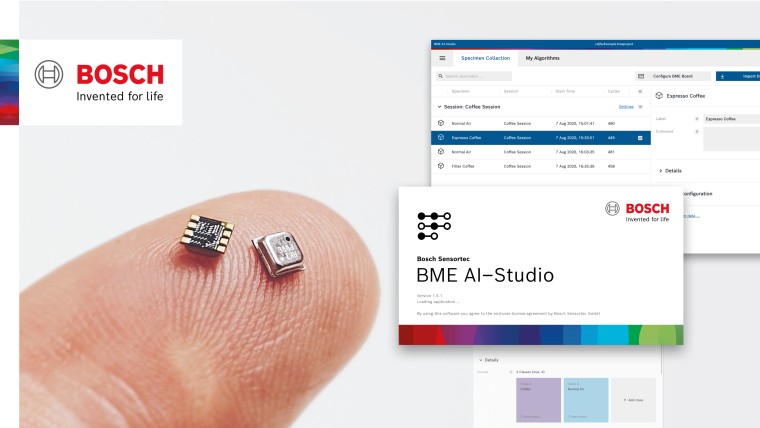Bosch BME688 4 in 1 Environmental Sensor
The Bosch BME688 is the world’s first 4 in 1 environmental sensor that uses artificial intelligence to adapt the sensor with regards to your use case.
The BME688 is the further development of the BME680 and measures the barometric pressure, temperature, humidity, and different gases.
Table of Contents
Bosch BME688 4 in 1 Environmental Sensor
The BME688 is a 4 in 1 environmental sensor, that can measure the following environmental influences in the specified measuring ranges:
- Barometric pressure: 300…1100 hPa
- Temperature: -40…85°C
- Humidity: 0…100%
- Gas: in parts per billion (ppb)
- Volatile Organic Compounds (VOCs)
- Volatile sulfur compounds (VSCs): bacteria growth
- Carbon monoxide
- Hydrogen
Regarding the measurement of the environment, the BME688 has no advantage to the BME680, that is also a 4 in 1 environment sensor. But the new BME688 is the first environmental sensor that supports artificial intelligence (AI) algorithms. The use of Artificial Intelligence not only increases the sensor’s range of use, but also customizes the sensor for individual applications.
As a further development of the BME680, the BME688 focuses on applications where different concentrations of gases have to be detected and classified. Application cases are for example:
- Detection of spoiled food in the refrigerator by increasing the concentration of volatile sulfur compounds (VSC).
- Classification of different types of coffee.
- Detection of full diapers.
Preconfigured Adafruit-Compatible Development Kit
The Bosch BME688 will be available at the end of March 2021 or beginning of April 2021. You can buy a preconfigured Adafruit-compatible development kit that you see in the following picture.

The preconfigured Adafruit development kit includes the following components, depending on the configuration that you can choose from the buyzero website:
- BME688 shuttle board with 8 BME688 sensors, 2 buttons for data labelling, a real time clock battery holder and a SD card slot
- Adafruit Huzzah32 – ESP32, with pre-soldered headers and pre-flashed Bosch firmware for the BME688 shuttle board
- 16 GB microSD card with config files
- CR1225 coin cell battery
BME688 Datasheet
The BME688 needs a supply voltage between 1.2V…3.6V and offers an I2C and SPI interface for the communication between the sensor and the microcontroller. The following table shows the average power consumption for different measurements because you can choose what environmental influence should be measured.
| Measurement | Sampling Rate | Power Consumption | |||
| Barometric Pressure | Temperature | Humidity | Gas | ||
| x | x | 1 Hz | 2.1 µA | ||
| x | x | 1 Hz | 3.1 µA | ||
| x | x | x | ULP | 90 µA | |
| x | x | x | LP | 0.9 mA | |
| x | x | x | x | 3.9 mA | |
BME688 Comparison to Other Environmental Sensors
There are a lot of different environment sensors on the market and maybe you are not sure if the BME688 is the right one for you. Therefore, the following table gives you a comparison between multiple environmental sensors, the communication interface, the measurement ranges, and the accuracy for each measurement.
| Sensor | Interface | Temperature Range (Accuracy) | Humidity Range (Accuracy) | Barometric Pressure (Accuracy) | Gas |
|---|---|---|---|---|---|
| DHT11 | Digital | 0°C…50°C (+-2°C) | 20%...80% (5%) | - | - |
| DHT22 | Digital | -40°C…80°C (+-0.5°C) | 0%...100% (2%...5%) | - | - |
| BMP180 | I2C | -40°C…85°C (+-0.1°C) | - | 300hPa…1100hPa (+-0.12hPa) | - |
| BMP280 | I2C, SPI | -40°C…85°C (+-0.5°C) | - | 300hPa…1100hPa (+-0.12hPa) | - |
| BME280 | I2C, SPI | -40°C…85°C (+-0.5°C) | 0%...100% (+-3%) | 300hPa…1100hPa (+-0.12hPa) | - |
| HDC1080 | I2C | -40°C…125°C (+-0.2°C) | 0%...100% (+-2%) | - | - |
| DS18B20 | Digital | -55°C…125°C (+-0.5°C) | - | - | - |
| BME680 | I2C, SPI | -40°C…85°C (+-0.5°C) | 0%...100% (+-3%) | 300hPa…1100hPa (+-0.12hPa) | x |
| BME688 | I2C, SPI | -40°C…85°C (+-0.5°C) | 0%...100% (+-3%) | 300hPa…1100hPa (+-0.12hPa) | x |
If you only need to measure the temperature, the humidity, and the barometric pressure, you should go with the BME280. But if you need on top a sensor for different gases, the BME680 is your choice. Only if you need special applications that are targeted to your special needs, like classify different coffees, the BME688 offers an advantage using artificial intelligence.
How to use the Artificial Intelligence of the BME688?
Now we want to know how to use artificial intelligence for the BME688. The good think is that you do not have to be a data scientist to use the sensor, because Bosch created a software, called BME AI-Studio tool that trains the BME688 sensor to special applications, like recognizing the footprint of different gas mixtures to detect different types of coffee beans.
The following steps describe the procedure to use the BME688 in combination with artificial intelligence:
- Record data: The first step is that we need quite a lot of data for the software to distinguish between different states. Therefore, you can put the sensor in a box with coffee beans and the data stream is written to an SD card.
- Label data: Now the sensor must know that you change the state. For this reason, the BME688 shuttle board has two buttons for the preparation of the labeling in the BME AI-Studio.
- BME AI-Studio tool: With the use of the BME AI-Studio tool, you can now rename the labeled data and the tool crates an algorithm that is able to differentiate between the different states.
The following video from Bosch Sensortec shows the Artificial Intelligence of the BME688 in detail

Microcontroller Datasheet eBook
The 35 pages Microcontroller Datasheet Playbook contains the most useful information of 14 Arduino, ESP8266 and ESP32 microcontroller boards.



